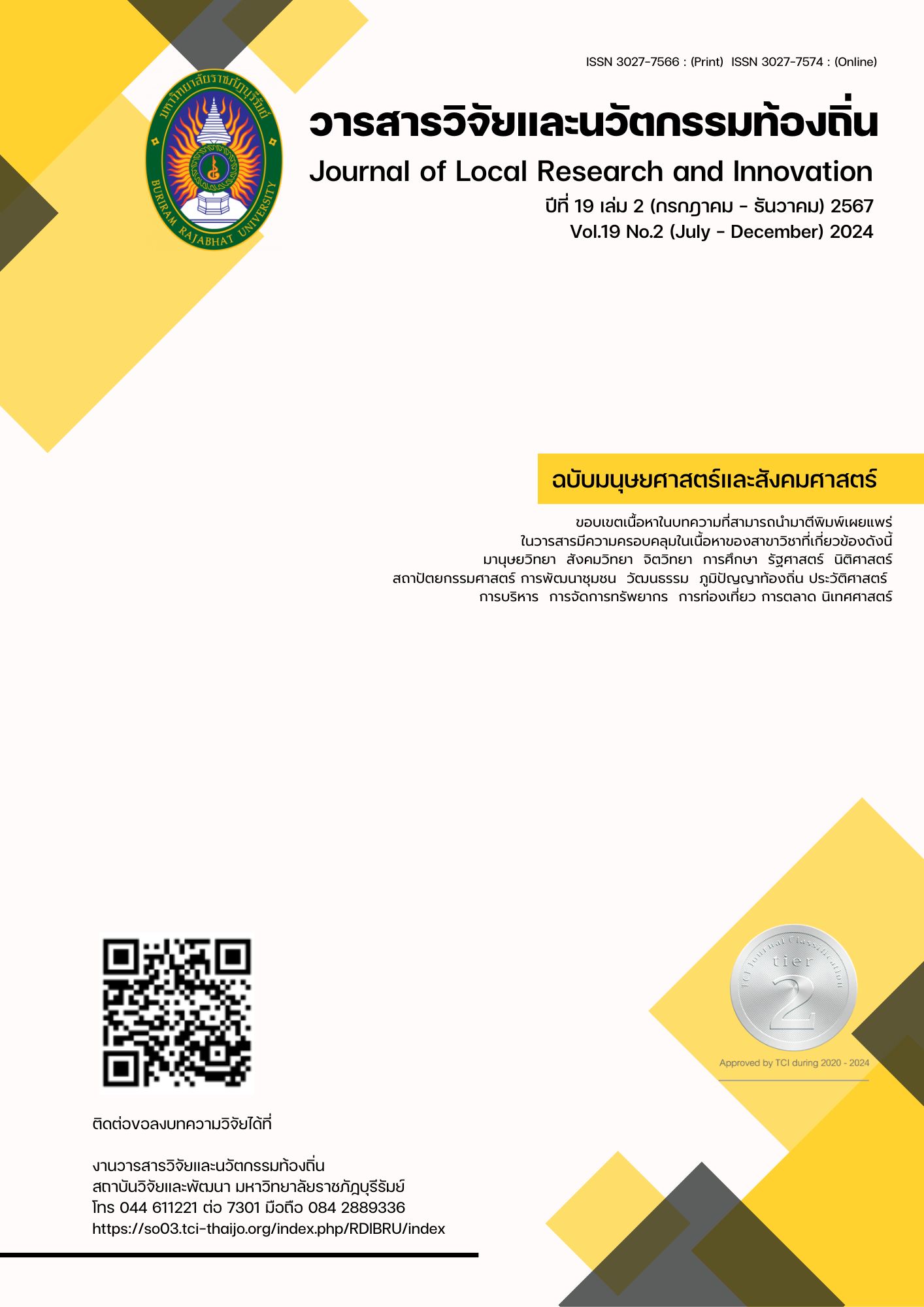การประยุกต์ใช้ทุนทางวัฒนธรรมกับการสร้างคุณค่าลายผ้าไหม ของชุมชนจังหวัดบุรีรัมย์
Main Article Content
Abstract
This research examines the application of cultural capital in creating value for silk patterns in Buriram Province communities. A qualitative research approach was employed, with data collected through in-depth interviews, focus group discussions, and community forums. The study explores the role of cultural capital in the creation of silk pattern value and how it can be applied to enhance the cultural and economic value of silk patterns in these communities. The findings reveal that silk weaving is a key form of local wisdom with significant cultural and economic importance. The study highlights the connection between cultural capital and the development of silk products. Weavers from various communities have developed silk patterns that reflect their way of life, history, and local beliefs. The integration of traditional weaving techniques with inspiration from nature has resulted in silk products that hold cultural value and are competitive in the market. It was also found that Buriram’s silk features unique patterns, with ongoing development of new designs to increase the value of the products. This encourages the community to preserve and transmit this knowledge to younger generations through training programs and the establishment of learning centers. Moreover, expanding access to broader markets for silk products contributes to higher income levels and supports the economic sustainability of the community.
Article Details

This work is licensed under a Creative Commons Attribution-NonCommercial-NoDerivatives 4.0 International License.
เนื่อหาและข้อมูลในบทความ เป็นความรับผิดชอบของผุ้แต่ง
บทความในวารสารเป็นลิขสิทธิ์ของวารสารวิจัยและพัฒนา มหาวิทยาลัยราชภัฏบุรีรัมย์
References
ชยภรณ บุญเรืองศักดิ์ และ สิริพรบูรณาหิรัณห์. (2567). การยกระดับนวัตกรรมชุมชนสู่การขับเคลื่อนทุนทางวัฒนธรรมในพื้นที่จังหวัดนครสวรรค์.วารสารศิลปการจัดการ. 8(2);45-62
ณัฐชยา รัตนพันธุ์ โสวัตรี ณ ถลาง และภัทรพรรณ ทำดี. (2566). การพัฒนาสินค้าทางวัฒนธรรมจากภูมิปัญญาผ้าไหมทอมือบ้านครัวโดยครอบครัวมนูทัศน์ เขตราชเทวี กรุงเทพมหานคร. วารสารวิจัยและพัฒนา มหาวิทยาลัยราชภัฏสวนสุนันทา. 15(1);1-17.
นลินี ทองประเสริฐ ปิยกนิฏฐ์ โชติวนิชและศุภกัญญา เกษมสุข. (2563). การพัฒนาผลิตภัณฑ์สู่ Premium OTOP ด้วยทุนทางวัฒนธรรมและภูมิปัญญาท้องถิ่นกรณีผ้าไหมย้อมสีธรรมชาติของกลุ่มสตรีทอผ้าบ้านหัวเมือง อำเภอมหาชนะชัย จังหวัดยโสธร.วารสารบัณฑิตวิทยาลัย พิชญทรรศน์. 15(1) ;95-108.
เศรษฐา ทวีสิน. (2566). คำแถลงนโยบายนายเศรษฐา ทวีสิน นายกรัฐมนตรี แถลงต่อรัฐสภาของคณะรัฐมนตรี. กรุงเทพฯ : สำนักเลขาธิการคณะรัฐมนตรี.
สำนักงานสภาพัฒนาเศรษฐกิจและสังคมแห่งชาติ. (2565). แผนพัฒนาเศรษฐกิจและสังคมแห่งชาติ ฉบับที่ 13 (พ.ศ. 2566-2570). กรุงเทพฯ : สำนักงานสภาพัฒนาเศรษฐกิจและสังคมแห่งชาติ สำนักนายกรัฐมนตรี.
Cheng, S. W. (2006). Cultural goods creation, cultural capital formation, provision of cultural services and cultural atmosphere accumulation. Journal of Cultural Economics. 30, 263-286.
Fauteux, B., Dahlman, I., & deWaard, A. (2013). The Cultural Capital Project: Radical monetization of the music industry. IASPM Journal. 3(1), 35-47.
Parameswara, A., & Wulandari, A. (2020). Sustaining local communities through cultural industries based on local wisdom in Tigawasa village. Journal of Sustainable Development. 13(6), 139-150.
Phuangsuwan, P., Siripipatthanakul, S., Praesri, S., Pariwongkhuntorn, N., & Khemapanya, V. (2024). Enhancing Community Economic Sustainability Based On Cultural Capital And Local Wisdom Knowledge Management: A Case Of Klong Maduea, Samut Sakhon. Journal Of Mcu Buddhapanya Review Vol. 9(2), 1-13
Prajnawrdhi, T. A., Karuppannan, S., & Sivam, A. (2015). Preserving cultural heritage of Denpasar: local community perspectives. Procedia Environmental Sciences. 28, 557-566.
Sawatdi, K., Yodmalee, B., & Paengsoi, K. (2013). Thai Silk Pattern: Conservation and Manufacturing Development to Create Added Value in the Province of Khon Kaen. International Journal of Academic Research in Business and Social Sciences. 3(9), 776.
Sullivan, A. (2008). Cultural capital, cultural knowledge and ability. Sociological Research Online, 12(6), 91-104.
Thomas, N. D. (2001). The importance of culture throughout all of life and beyond. Holistic nursing practice. 15(2), 40-46.

